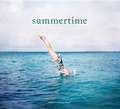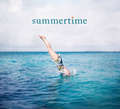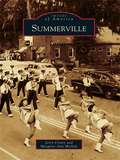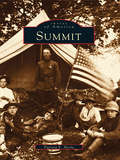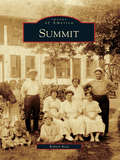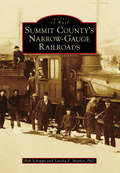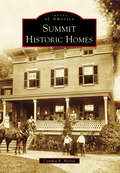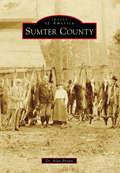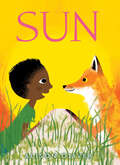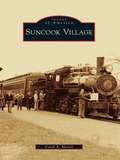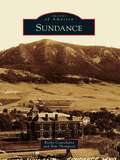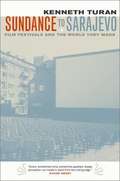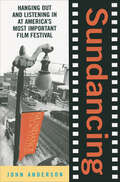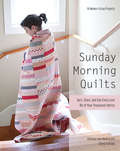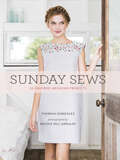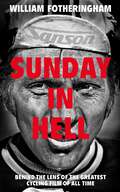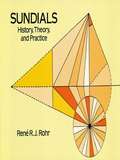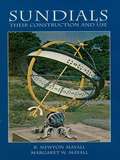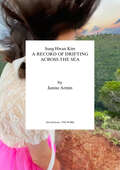- Table View
- List View
Summertime
by Joanne DuganSummer is the best season of all, with its long days, blue skies, and endless horizons. Summertime collects more than 100 photos that capture the essence of the season from such highly acclaimed photographers as Joel Meyerowitz, Martin Parr, and Peter Marlow. Quotes from luminaries intermingle with dreamy pictures--sandy toes, empty docks, blue water--that instantly evoke the perfect summer moment. A jacketed hardcover, Summertime is casual, elegant, and ideally sized for the summer cottage coffee table--the perfect gift for weekend hosts, or those who long for an escape to their favorite season all year round.
Summertime
by Joanne DuganSummer is the best season of all, with its long days, blue skies, and endless horizons. Summertime collects more than 100 photos that capture the essence of the season from such highly acclaimed photographers as Joel Meyerowitz, Martin Parr, and Peter Marlow. Quotes from luminaries intermingle with dreamy pictures—sandy toes, empty docks, blue water—that instantly evoke the perfect summer moment. A jacketed hardcover, Summertime is casual, elegant, and ideally sized for the summer cottage coffee table—the perfect gift for weekend hosts, or those who long for an escape to their favorite season all year round.
Summerville
by Margaret Ann Michels Jerry CrottySummerville's original motto, Sacra Pinus Esto, "The Pine is Sacred," hints at how serious the founders were about protecting their towering indigenous pines. Summerville owes its settlement--and early 20th-century development as an international tourism destination--to the fragrant cool air provided by the shade of the grand pines. Settled in the late 1600s by plantation owners along the Ashley River as an escape from summer heat, Summerville later became a retreat from cold northern winters. Today the town is known for its annual Flowertown Festival. The new town slogan, "The Flower Town in the Pines," is a friendlier version of the first, combining healthy respect for the ancient pines with love for the multicolored blossoms that appear anew each spring. The village is a combination of small town and bustling suburb, with plenty of Southern history to explore.
Summit (Images of America)
by Patricia E. MeolaWith a history dating back to 1664, Summit, New Jersey, has evolved from a pastoral town of farms and rolling hills to a populated suburb of Manhattan.In this original collection of images, author and local historian Patricia E. Meola takes readers on a journey into Summit's past. Witness the growth and change that have occurred in Summit since its incorporation in 1899 in this fascinating pictorial history. Through nearly 200 postcard images, Summitcelebrates a city known for its gracious, tree-lined streets, the reputation of its public and private schools, the activism of countless city volunteers, and its thriving opportunities for culture and adult education. In the early days of the community's development, many residents were seasonal (this attribute of the population changed as it became easier to live in the country and work in the city). Some of the postcards that were sent to friends and relations by early summer inhabitants have been reproduced in this book.
Summit (Images of America)
by Robert KottSummit, fittingly named after its location astride a rise, was built on that low ridge crossed by travelers seeking a convenient route into America's interior. As a portal to the North American interior, Summit's land has witnessed the travels and pauses of Native Americans, French explorers and missionaries, fur traders, the English, and finally Colonial Americans. To this day, it remains synonymous with unsurpassed transportation advantages, having stimulated considerable commercial, industrial, and urban growth. From its earliest hut to its latest futuristic library, Summit has played an irreplaceable role in the progress of the United States.
Summit County's Narrow-Gauge Railroads (Images of Rail)
by Bob Schoppe Sandra F. MatherSummit County's Narrow-Gauge Railroads tells the story of the two railroads that fought for dominance in Summit County, Colorado, during the late 1800s and early 1900s: the Denver, South Park & Pacific and the Denver & Rio Grande. The two railroads developed an intense rivalry as they sought to monopolize the county's economic potential. Altitude, heavy winter snow, and rugged mountainous terrain combined to provide a unique set of challenges to company management as well as to the crews as they battled to lay the tracks and provide much-needed rail service to the residents and businesses of the county. Intimately tied to the mining economy, the fortunes of the railroads plummeted when the mining economy collapsed. Although poorly financed and poorly built, the railroads changed the living conditions for county residents. Without the railroads bringing the necessary equipment and lumber, nine huge gold-dredging boats would not have scoured the county's major waterways between 1898 and 1942.
Summit Historic Homes (Images of America)
by Cynthia B. MartinOriginally sought out by city dwellers as a refuge from the tribulations of urban life, Summit developed from a bucolic rural spot in 1836 to a fully established suburb by 1940. The town's growth was intrinsically tied to the development of the railroad and the convenience of the commute it offered to nearby New York City. The houses constructed during these years reflected their owner's wealth, social standing, and aesthetic sensibilities, and exemplified the trends of their times. Some of these houses served as summer residences; others as primary dwellings. Some were designed by well-known architects; others by local talent. Many of these residences are still standing, although some have been altered or even demolished to suit modern lifestyles. Today, many Summit residents still commute to New York. Summit Historic Homes tells the story of Summit's early development by focusing on the expansion of the railroad and the houses built by the city dwellers who moved here as a result.
Summit Up
by Anton KazlauciunasThe more we look, the more we see. The more we see, the more we understand. With our eyes we see, we ruminate, speculate, compare, compose, even cogitate a little, animadvert perhaps, create balance, empathy, order out of chaos, understanding rises from conflict, beauty out of the undefined, trust replaces prejudice and suspicion, light emerges from the darkness, love out of hate, peace from war. We create hopes of dreams, belief out of impossibility, reality materializes from imagination. And so artists draw. Please read the pictures and think for yourselves.
Sumter County
by Alan BrownSumter County was founded on December 18, 1832, on land ceded to the United States by the Choctaw Indians in the Treaty of Dancing Rabbit Creek. Almost immediately, settlers began pouring in from Georgia, Virginia, Tennessee, and the Carolinas. In the 19th and early-20th centuries, most of the residents were farmers; however, following the infestation of the boll weevil, many turned to raising cattle and growing timber. Every November, hundreds of hunters descend upon Sumter County in hopes of harvesting one of the thousands of deer that live on the rolling prairies and in the oak forests lining the Tombigbee River. With the help of Ruby Pickens Tartt, scores of ethnomusicologists, including John and Alan Lomax, traveled hundreds of miles to the red clay country of Sumter County in the 1930s, 1940s, and 1950s to record African American folk songs from people like Vera Hall and Dock Reed.
Sun
by Alison OliverSun, a sporty boy, reconnects with his artistic side in this gorgeous, joyful celebration of creativity that offers an expanded and appealing model for boyhood. Sun loves everything about playing soccer: the cheers, the competition, the winning. But he feels as though something is missing. When he sees his younger brother spread out on the floor, creating a wondrous piece of art, he remembers how much he loves to make things. He goes to the beach to think, and it&’s there that a magical encounter with a fox helps him reconnect with a long-forgotten source of happiness. Simple words and stunning illustrations pair to show us there is more than one way to be a boy…and remind us of the deep satisfaction of creativity.
Sunbeam on the Astronaut
by Steven CerioA long-awaited collection of comics, art, and stories by artist Steven Cerio that explores silly, psychedelic, and strange worlds.<P><P> Smiling cartoon critters carouse with threatening cutout whales against a shifting comic landscape in these unique illustrated stories. The psychedelic meets Saturday morning cartoons in stories with such intriguing titles as "A Private History of Sunbeams and Head Colds," "The Add Witch in The Berry Patch," and "Ninny Noonday Ninny."Steven Cerio is a prominent rock poster and magazine illustrator. His work is best known from his ongoing collaboration with San Francisco-based performance art and music group The Residents.
Suncook Village
by Carol MartelLocated within the boundaries of the towns of Allenstown and Pembroke, Suncook, first granted as a township in 1728, has developed a rich history all its own. Railroad transportation was instrumental to the establishment and growth of three large textile mills. The first railroad system, the Concord and Portsmouth line, began in 1852. A second line, the Suncook Valley Railroad, followed in 1869. Drawn by advertisements in Canadian newspapers, French Canadian workers began migrating from Quebec in large numbers. By the late 1800s, Suncook had become known as "le Petit Canada." The power of the Suncook and Merrimack Rivers, scenic beauty in the area, and the connectivity brought through transportation helped transform a small industrial village into a vibrant and lasting community.
Sundance
by Rocky Courchaine Pam ThompsonSundance, in the northeast corner of Wyoming, may not be the only place with that name, but it is the original Sundance--the place where the Kid got his name. There was no settlement of any sort when Crook County was created in 1875. The town was founded in 1878, named after the mountain that stands south of town where the Plains tribes held their sun dance ceremonies. Sundance is not that different from the many other small towns that sprang to life in the boom of gold, cattle, and oil throughout the West, but it is different in that it has ridden through the booms and the busts and still survives. This book contains images of people's lives as they worked and played, lived and died. It tells of those who passed through, and those who stayed and helped the community establish its roots and grow.
Sundance to Sarajevo: Film Festivals and the World They Made
by Kenneth TuranA journalistic account of all the superficial glitz that we associate with film festivals, along with an account of the serious business that goes on there, and of the politics behind the glamor. There have been books about individual festivals, but never anything as comprehensive as this.
Sundance to Sarajevo: Film Festivals and the World They Made
by Kenneth TuranAlmost every day of the year a film festival takes place somewhere in the world--from sub-Saharan Africa to the Land of the Midnight Sun. Sundance to Sarajevo is a tour of the world's film festivals by an insider whose familiarity with the personalities, places, and culture surrounding the cinema makes him uniquely suited to his role. Kenneth Turan, film critic for the Los Angeles Times, writes about the most unusual as well as the most important film festivals, and the cities in which they occur, with an eye toward the larger picture. His lively narrative emphasizes the cultural, political, and sociological aspects of each event as well as the human stories that influence the various and telling ways the film world and the real world intersect. Of the festivals profiled in detail, Cannes and Sundance are obvious choices as the biggest, brashest, and most influential of the bunch. The others were selected for their ability to open a window onto a wider, more diverse world and cinema's place in it. Sometimes, as with Sarajevo and Havana, film is a vehicle for understanding the international political community's most vexing dilemmas. Sometimes, as with Burkina Faso's FESPACO and Pordenone's Giornate del Cinema Muto, it's a chance to examine the very nature of the cinematic experience. But always the stories in this book show us that film means more and touches deeper chords than anyone might have expected. No other book explores so many different festivals in such detail or provides a context beyond the merely cinematic.
Sundancing: Hanging Out and Listening In at America's Most Important Film Festival
by John AndersonEvery winter, 8,000 feet above sea level in the Utah snow, the hopes and dreams of young moviemakers are put on display at the Sundance Film Festival--the haven for independent films where you can show up a kid and go home a star. In barely twenty years of existence, the festival--now overseen by Robert Redford's Sundance Institute--has assumed tremendous importance for today's film culture: during the annual ten-day event, tiny Park City is so overrun by agents, publicists, studio executives, and other Hollywood types that in 1988 they blew out the town's cell-phone relay system.
Sunday Morning Quilts: Sort, Store, and Use Every Last Bit of Your Treasured Fabrics
by Amanda Jean Nyberg Cheryl ArkisonA collection of modern quilting projects you can create with scraps.Are scrap piles wreaking havoc in your sewing space? Not sure what to do with all those tiny bits of gorgeous prints you hate to part with? Modern quilters Amanda Jean Nyberg and Cheryl Arkison share a passion for scraps, and they&’re here to help you get creative with 16 scrappy quilt projects that include piecing, appliqué, and improvisational work. This book has ideas on how to adapt patterns for your own personal &“Sunday morning&” style, plus tips for effectively cutting, storing, and organizing your scraps. Your Sunday mornings just got a whole lot cozier!&“Sunday Morning Quilts shows you how to use every last scrap of treasured fabric in your collection…The book champions the original ethos behind patchwork—make do and mend…The quilts are bold, bright and clean, and the co-authors actively encourage you to be creative and to come up with your own designs.&”—Popular Patchwork Magazine
Sunday Sews: 20 Inspired Weekend Projects
by Theresa GonzalezSunday Sews presents 20 irresistible designs that can be sewn on a weekend and enjoyed for a lifetime. Featuring minimalist style and unfussy lightweight fabrics, they are as functional as they are chic. Think drapey shift dresses, flattering tunics and skirts, tanks and tops perfect for layering, pretty aprons, go-anywhere tote bags, and gifts for children and loved ones. Step-by-step instructions and technical illustrations make construction a breeze, whatever the reader's skill level; and lush photographs showcase the finished projects in clean, uncluttered settings. Brimming with atmosphere, Sunday Sews evokes everything we love about the most relaxing day of the week.
Sundays at Eight: 25 Years of Stories from C-SPAN'S Q&A and Booknotes
by Brian Lamb C-SpanFor the last 25 years, Sunday nights at 8pm on C-SPAN has been appointment television for many Americans. During that time, host Brian Lamb has invited people to his Capitol Hill studio for hour-long conversations about contemporary society and history. In today's soundbite culture that hour remains one of television's last vestiges of in-depth, civil conversation.First came C-SPAN's Booknotes in 1989, which by the time it ended in December 2004, was the longest-running author-interview program in American broadcast history. Many of the most notable nonfiction authors of its era were featured over the course of 800 episodes, and the conversations became a defining hour for the network and for nonfiction writers.In January 2005, C-SPAN embarked on a new chapter with the launch of Q and A. Again one hour of uninterrupted conversation but the focus was expanded to include documentary film makers, entrepreneurs, social workers, political leaders and just about anyone with a story to tell.To mark this anniversary Lamb and his team at C-SPAN have assembled Sundays at Eight, a collection of the best unpublished interviews and stories from the last 25 years. Featured in this collection are historians like David McCullough, Ron Chernow and Robert Caro, reporters including April Witt, John Burns and Michael Weisskopf, and numerous others, including Christopher Hitchens, Brit Hume and Kenneth Feinberg.In a March 2001 Booknotes interview 60 Minutes creator Don Hewitt described the show's success this way: "All you have to do is tell me a story." This collection attests to the success of that principle, which has guided Lamb for decades. And his guests have not disappointed, from the dramatic escape of a lifelong resident of a North Korean prison camp, to the heavy price paid by one successful West Virginia businessman when he won $314 million in the lottery, or the heroic stories of recovery from the most horrific injuries in modern-day warfare. Told in the series' signature conversational manner, these stories come to life again on the page. Sundays at Eight is not merely a token for fans of C-SPAN's interview programs, but a collection of significant stories that have helped us understand the world for a quarter-century.
Sundials: History, Theory, and Practice
by René R.J. Rohr"His lively pen, his direct and simple style, his expressive vocabulary, his avoidance of pedantry, his conciseness in the exposition of his thoughts make his book a pleasure to read." -- Henri Michel, International Academy of the History of ScienceThe story of man's efforts to measure time is a long one -- reaching back thousands of years to the dawn of civilization. Among the earliest instruments developed for telling time was the sundial. In this expert study, a noted sundial expert offers a fascinating and informative account of these ancient devices, presented in simple, lively language.Over the centuries, many different varieties of sundials have been constructed, and Mr. Rohr provides detailed, accurate descriptions of them all: classical sundials, inclined dials, solar calendars, analemmatic dials, moon dials, and many more. There is even a chapter devoted to especially remarkable dials past and present, and a listing of the most popular sundial mottoes. In this profusely illustrated volume, you will not only learn about the long and colorful history of the sundial, you will learn a practical method of building one yourself. No special knowledge is required, other than an understanding of the basic principles of cosmography and of the relative movements of the sun and the planets. (These are recalled in an elementary way in a special chapter.) For mathematically inclined readers, more complex formulae and calculations have been included, some of which have never been printed in a book of gnomonics.
Sundials: Their Construction and Use
by R. Newton Mayall Margaret W. MayallTo many people, the construction of a sundial implies laborious mathematical calculations and a knowledge of astronomy. Nothing could be farther from the truth. This fascinating handbook, used in conjunction with ordinary tools and materials found around the home, makes it easy to design and construct a sundial on almost any surface and in virtually any position. Introductory chapters offer a wealth of information on the sundial's development from ancient times to the present, why the sundial tells time, how to design and make a dial, and more. These chapters are followed by full instructions on how to construct the hour lines for many kinds of sundials, by the graphic or geometric method. The use of this method doesn't require a knowledge of mathematics or astronomy. It simplicity and accuracy, together with the ease and quickness of delineation, make it very practical. Readers will also find fascinating chapters on dial furniture, portable sundials, constructing a heliochronometer (a highly precise solar timekeeper), sundial classification, and other topics. Accompanying the text are 150 well-chosen illustrations, many published for the first time. They depict scale models, as well as a moon dial, a cathedral dial, and other actual dials from around the world, including the world's largest, in Jaipur, India. If you've ever wanted to build your own sundial, or if you simply want to know more about these ancient timepieces that can show the time of day as accurately as many clocks, this clearly written, easy-to-follow guide is "the best book available." -- Commonweal.
Sundials: Their Theory and Construction
by Albert WaughHave you every wanted to build a sundial or to understand how one works? Then you have probably been frustrated as you search vainly for help. Most books on the subject are either rare out-of-print works published centuries ago and available only in highly specialized collections, or highly complicated treatises whose information is hidden behind frightening arrays of involved formulas. But now your search is over. This book is designed to meet sundialing needs at either the simple or the sophisticated level. Albert E. Waugh, professor and administrator at the University of Connecticut for 40 years, and an expert on the subject of sundials and their curious history, presents, on the one hand, a rigorous appraisal of the science of sundials, including mathematical treatment and an explanation of the pertinent astronomical background; on the other hand, he presents simple and non-technical treatments such that several of the dials can be built by children!The subject matter is arranged in 19 chapters, each covering a different aspect of dialing science. All the common types of dials are covered, but the reader can also learn about analemmatic dials, polar dials, equatorial dials, portable dials, memorial dials, armillary spheres, reflected ceiling dials, cross dials, and old-fashioned noon marks. There are also sections on dial furniture, mottoes, the actual layout out of a dial, the equation of time, finding time in other cities, how to find the meridian, how to find time by moonlight -- even how to estimate time from the length of one's own shadow! Directions are given for designing dials for any part of the country, or any place in the world. The author has designed many dials, and his text is filled with helpful hints based on his own personal experience. There are over 100 illustrations, charts, and tables, followed by an appendix which is filled with material which reduces or eliminates the need for calculation on the part of the reader.
Sunflower Houses: Inspiration From the Garden--A Book for Children and Their Grown-Ups
by Sharon LovejoyA magical book of adventures and appreciations written and illustrated by the author of Roots, Shoots, Buckets & Boots this award-winning title was published by a small press in Colorado in 1991. The reviews say it all: A fetching primer on gardening for children. . . . Irresistible (The Smithsonian). What child, or indeed adult, would not be delighted? Lovejoy's recollections are wonderful, as are the illustrations (Victoria). Celebrating the lore of the garden and the joy of interacting with nature, Sunflower Houses is a unique garden lover's miscellany, a collection of memories, poems, activities, garden plans, crafts, botanical riddles, stories, games, and planting projects. There are inspirations for a Floral Clock Garden, A Child's Own Rainbow, Faerie Tea Parties, and, of course, the Sunflower House. Plus, from garden lovers, stories of favorite flowers. Throughout are the artist's warm and appealing watercolors of a life in gardening remembered.
Sung Hwan Kim: A Record of Drifting Across the Sea (Afterall Books / One Work)
by Janine ArminA richly illustrated exploration of Sung Hwan Kim&’s complex record of migrant stories, displacement and belonging, border-crossings and translation.In A Record of Drifting Across the Sea (2017–), Sung Hwan Kim turns to past histories of migration. The artist parses the traces—archival and bodily—left by undocumented Korean migrants who came to the US by way of Hawai&’i at the turn of the last century, and ponders over their impact on other migrant and indigenous communities. As an ongoing film and installation series, comprising two chapters and a third in progress, A Record unsettles the limits of the "one work" with its distributive, open-ended and collaborative nature. In this speculative inquiry, Janine Armin explores each chapter in Kim&’s multilayered work as a mycelial network of feelers entangling and extending the wider work in process. Engaging history through the senses, folklore and myth, as much as through archival material, Kim navigates and crosses the boundaries between displacement and belonging. Focusing on the artist&’s attempt to escape from representation, Armin illuminates and attends to the different stories and non-sovereign ways of being together towards which his work points us. This title is part of the One Work book series, which focuses on artworks that have significantly changed the way we understand art and its history.
